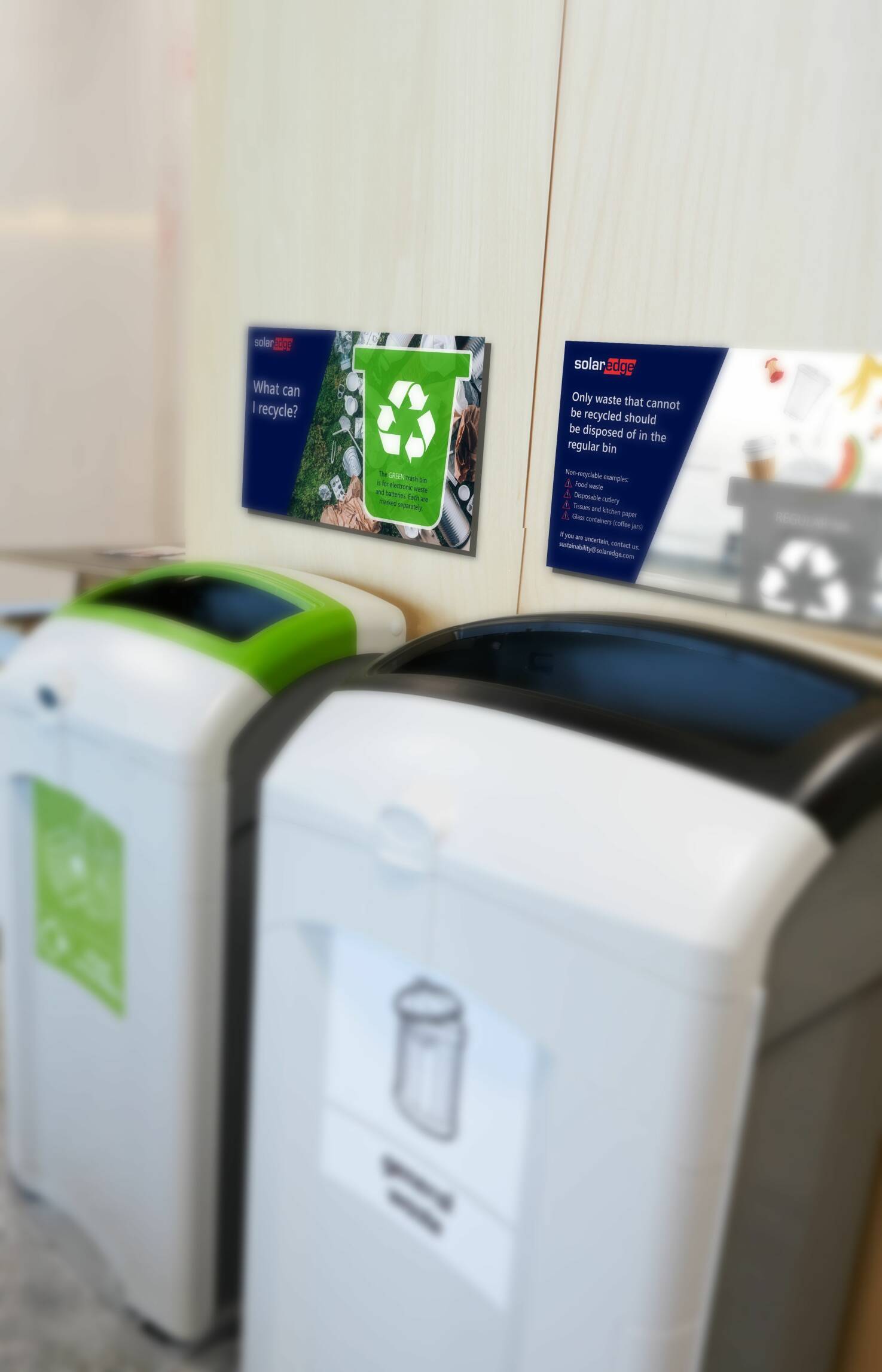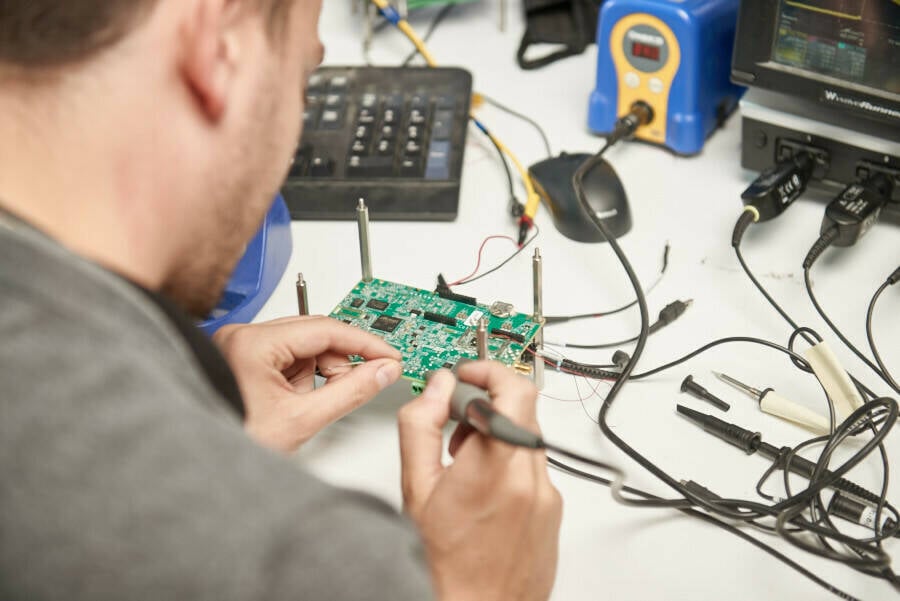

In recent years, we have been operating an enhanced recycling program for our headquarters in Herzliya Israel to further engage our employees in environmental practices while contributing to the reduction of our environmental impact. Supported by our employees that volunteered as recycling champions, we installed recycling bin systems at different locations throughout our offices and educated employees on how to separate office waste effectively. The program includes separate bins for food and plastic packaging, paper, drink containers, e-waste, batteries and expired medicine.
We recently added aerosol collection containers on various factory floors at Sella 1 in Israel. The containers are collected by a local recycling partner, who empties any remaining gases and sends remaining metals for scrap reuse.
Examples of Site Recycling Programs


In 2023, 76% of our total waste generated was sent for recycling, with an additional 7% of total waste sent to incineration with energy recovery.
We have recently set a target regarding the waste (of all types) generated at our sites, aiming for >80% of generated waste to be recycled or recovered to energy each year. This target has been met for both 2022 and 2023.
At some of our sites- for example, at Sella 1, non-household waste including hazardous waste, carboard, scrap metal and e-waste is separated at the source and sent for external recycling at licensed facilities. We recognize the challenges of electronic waste as a contributor to environmental degradation and are examining further options to reduce electronic waste from our supply chain with a target to achieve near-zero electronic waste-to-landfill.
All e-waste generated directly at our manufacturing, R&D and logistic sites is collected and handled by certified WEEE (Waste Electrical and Electronic Equipment) handlers and recyclers. In general, our products are designed for long-term use and carry multi-year warranties (10-25 years). Nonetheless, we work to ensure the recyclability of our products for their eventual end-of-life stages. Through our long-term engagement with our main e-waste handling companies, we have learned that our solar products (such as inverters and Power Optimizers) can be recycled, and in a cost-effective manner.
Among other actions, we have ensured that the potting (protective polyurethane filling) that coats the assembled circuit boards and critical parts of our Power Optimizers does not create an obstacle for the recycling of the valuable electronic components. The e-waste handling companies have demonstrated to us their developed methods for successfully separating the potting material from the encased e-waste. The potting is also a key factor in assuring the longevity of our Power Optimizers, helping to protect them from weather conditions through their 25 years of warranted lifetime. This allows for reduced material consumption and reduced waste generation, while achieving the increased power production that our systems allow.
In the past years, we have conducted on-site visits with some of our main e-waste handling companies and have found the on-site recycling processes for our products to operate according to our expectations.
As storage solutions continue to form a significant part of SolarEdge’s activities, offerings, and revenues, we are working to ensure correct treatment of these products once they reach their end-of-life. For further information please see Product End-of-Life.
We will continue to examine the recyclability of our products (across all company affiliates) to ensure their compatibility within the new circular economy.
We aim to minimize waste from our operations and reuse or recycle what we cannot eliminate. We generate modest amounts of waste from our office activities, R&D laboratories and production facilities.
Sustainability Report 2023 /
Waste
Management
Join the SolarEdge Conversation
Contact our sustainability / ESG team
Contact us
How can we help you?
Join the SolarEdge Conversation
Contact our sustainability / ESG team
Contact us
How can we help you?
In 2023, 76% of our total waste generated was sent for recycling, with an additional 7% of total waste sent to incineration with energy recovery.
In recent years, we have been operating an enhanced recycling program for our headquarters in Herzliya Israel to further engage our employees in environmental practices while contributing to the reduction of our environmental impact. Supported by our employees that volunteered as recycling champions, we installed recycling bin systems at different locations throughout our offices and educated employees on how to separate office waste effectively. The program includes separate bins for food and plastic packaging, paper, drink containers, e-waste, batteries and expired medicine.
We recently added aerosol collection containers on various factory floors at Sella 1 in Israel. The containers are collected by a local recycling partner, who empties any remaining gases and sends remaining metals for scrap reuse.
Examples of Site Recycling Programs
We have recently set a target regarding the waste (of all types) generated at our sites, aiming for >80% of generated waste to be recycled or recovered to energy each year. This target has been met for both 2022 and 2023.
At some of our sites- for example, at Sella 1, non-household waste including hazardous waste, carboard, scrap metal and e-waste is separated at the source and sent for external recycling at licensed facilities. We recognize the challenges of electronic waste as a contributor to environmental degradation and are examining further options to reduce electronic waste from our supply chain with a target to achieve near-zero electronic waste-to-landfill.
All e-waste generated directly at our manufacturing, R&D and logistic sites is collected and handled by certified WEEE (Waste Electrical and Electronic Equipment) handlers and recyclers. In general, our products are designed for long-term use and carry multi-year warranties (10-25 years). Nonetheless, we work to ensure the recyclability of our products for their eventual end-of-life stages. Through our long-term engagement with our main e-waste handling companies, we have learned that our solar products (such as inverters and Power Optimizers) can be recycled, and in a cost-effective manner.
Among other actions, we have ensured that the potting (protective polyurethane filling) that coats the assembled circuit boards and critical parts of our Power Optimizers does not create an obstacle for the recycling of the valuable electronic components. The e-waste handling companies have demonstrated to us their developed methods for successfully separating the potting material from the encased e-waste. The potting is also a key factor in assuring the longevity of our Power Optimizers, helping to protect them from weather conditions through their 25 years of warranted lifetime. This allows for reduced material consumption and reduced waste generation, while achieving the increased power production that our systems allow.
In the past years, we have conducted on-site visits with some of our main e-waste handling companies and have found the on-site recycling processes for our products to operate according to our expectations.
As storage solutions continue to form a significant part of SolarEdge’s activities, offerings, and revenues, we are working to ensure correct treatment of these products once they reach their end-of-life. For further information please see Product End-of-Life.
We will continue to examine the recyclability of our products (across all company affiliates) to ensure their compatibility within the new circular economy.
We aim to minimize waste from our operations and reuse or recycle what we cannot eliminate. We generate modest amounts of waste from our office activities, R&D laboratories and production facilities.











